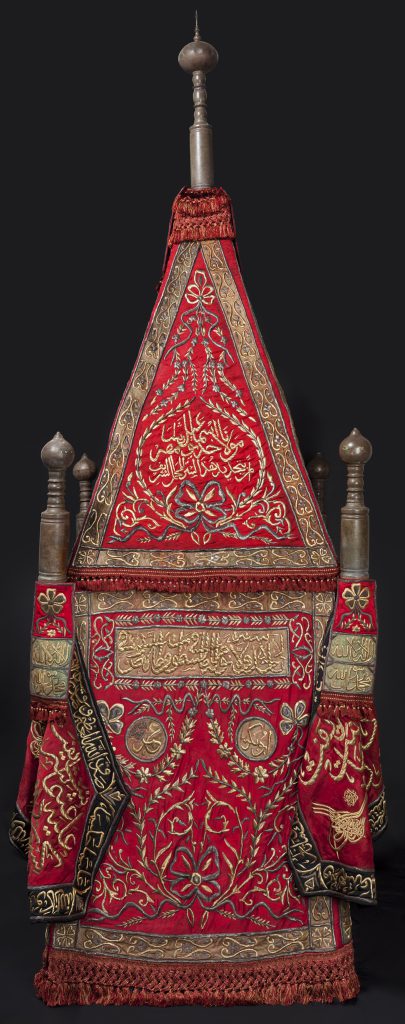



Title: Mahmal
Date: 1867–76
Location: Cairo, Egypt
Materials: mahmal cover, banners and finial banners of red silk, with green and gold-coloured silk appliqués, embroidered in silver and silver-gilt wire over cotton thread padding; finials of copper alloy; contemporary wooden frame
Dimensions: 400 (approximate height, as assembled) x 130 x 102cm
Accession Number: TXT 442
Other Notes:
The mahmal was a ceremonial palanquin that represented the authority of the Sultan over the Holy Places. It was carried by a camel – specially chosen for the purpose for its appearance and strength. The Mamluk sultan Baybars (r 1260 – 1277) is reported to be the first to have sent a mahmal with the caravan of pilgrims from Cairo, and the custom was continued under Ottoman rule and almost without interruption until the early 20th century. Following the Ottoman conquest of Egypt, a second mahmal – also representing the Ottoman sultan – left Damascus with the caravan of Syrian and Turkish pilgrims. [see ARC.pp 30.9] The Egyptian and Syrian mahmals were occasionally joined by a third mahmal from the Yemen. [see MSS 1038, folio 29a, where the three mahmals are shown at the bottom of the image]
Great celebrations accompanied the departure of the Egyptian mahmal from Cairo and its return to the city. The mahmal and the various textiles that make up the kiswah of the Ka‘bah were paraded in the streets of Cairo before being officially handed over to the Amir al-Hajj, the Commander of the pilgrim caravan. [see ARC.pt 76; ARC.pt 83; ARC.pt 101; ARC.pt 123]
This sitr (‘cover’) for the mahmal is one of seven (three Syrian and four Egyptian) mahmals in the Khalili Collection. The earliest is a Syrian mahmal cover in the name of Sultan Muhammad (Mehmet) IV, dated AH 1076 (AD 1656–7) [see TXT 289], while the latest, an Egyptian mahmal, is in the names of the Ottoman sultan ‘Abd al-Hamid (Abdulhamid) II and the Egyptian khedive ‘Abbas Hilmi II, and bears two dates, 1316 and 1318 AH (1898–9 and 1900–01 AD).
The Egyptian mahmal had two covers: an official, richly embroidered one such as TXT 442, which was used during the various parades, when the caravan passed through major cities, as the caravan entered Mecca, and as it entered Medina and the Prophet’s mosque. This cover was not renewed annually, but was used over several years. The second ‘daily’ cover was a simple one, normally green in colour and with appliqué decoration [see ARC.pp 40]. In the 19th and early 20th century (if not earlier) the embroidered cover was replaced by the simple daily cover as the mahmal was carried into the Holy Sanctuary in Mecca.
TXT 442 comprises the sitr itself – a tent-like cover with a pyramidal roof and an almost-square base with a slit opening at the front; a contemporary wooden frame with five finial supports; five finials, four for the corners and a larger one for the top; five small banners, one for each finial; and two larger double-sided banners (bayraq) bearing the name of the Ottoman State. The large central finial, which bears the name and tughra of Sultan Mahmud II (r 1808–1839), was obviously reused.
Zoom
Close
